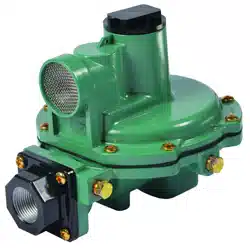Loading ...
Loading ...
Loading ...

©Emerson Process Management Regulator Technologies, Inc., 2001, 2015; All Rights Reserved
R600 and HSRL Series LP-Gas Regulators
The Emerson logo is a trademark and service mark of Emerson Electric Co. All other marks are the property of their prospective owners. Fisher
®
is a mark owned by Fisher Controls International LLC,
a business of Emerson Process Management.
The contents of this publication are presented for informational purposes only, and while every effort has been made to ensure their accuracy, they are not to be construed as warranties or
guarantees, express or implied, regarding the products or services described herein or their use or applicability. We reserve the right to modify or improve the designs or specications of such
products at any time without notice.
Emerson Process Management Regulator Technologies, Inc. does not assume responsibility for the selection, use or maintenance of any product. Responsibility for proper selection, use and
maintenance of any Emerson Process Management Regulator Technologies, Inc. product remains solely with the purchaser.
LPG Equipment
Emerson Process Management
Regulator Technologies, Inc.
USA - Headquarters
McKinney, Texas 75070 USA
Tel: +1 800 558 5853
Outside U.S.: +1 972 548 3574
For further information visit www.fisherregulators.com
Vent Opening
Make sure the regulator vent, vent assembly or vent tube does
not become plugged by mud, insects, ice, snow, paint, etc. The
vent screen aids in keeping the vent from becoming plugged
and the screen should be clean and properly installed. Make
sure any irrigation system operated near a regulator or vent line
does not spray water into the vent opening of the regulator or
vent assembly.
Water Inside Regulators from
Floods, Weather or Water Table on
Underground Systems
Replace any regulator that had water in their spring case,
has been flooded, has been submersed below the water
table of an underground tank or shows evidence of external
or internal corrosion. Checking for internal corrosion can
be done by removing the closing cap and with the aid of a
flashlight observing the condition of the relief valve spring,
main spring and internal spring barrel area. A more detailed
examination will require shutting down of the gas system
and the complete removal of the adjusting screw. Closely
examine regulators installed with their vent horizontal for
signs of corrosion. Correct any improper installations.
Regulator Replacement
Older regulators are more likely to catastrophically fail
because of worn or corroded parts. Replace R600 and
HSRL Series regulators over 20 years of age. Other service
or environmental conditions may dictate replacement of the
regulator before it becomes 20 years old. Regulators that are
installed in corrosive environments including but not limited
to the following conditions should be inspected annually
for visual indication of external or internal corrosion and
paint chipping or flaking. Regulators in these applications
may require replacement sooner and must be replaced if
corrosion is evident:
• Regulators that are installed in areas subject to sea salt
(coastal) atmosphere
• Regulators that are installed on underground systems
• Regulators installed with underground vent piping
• Regulators that are used in installations where the gas
system is only operated and pressurized intermittently
Refer to Fisher
®
Bulletin LP-32 for additional information.
Regulator Repair
Regulators that have been disassembled for repair must be
tested for proper operation before being returned to service.
Only parts manufactured by Fisher should be used to repair
Fisher regulators. Be sure to give the complete type number
of the regulator when corresponding with the factory.
The type number, orifice size and spring range are on a label
attached to the spring barrel. The date of manufacture is
stamped on the regulator. Always provide this information in
any correspondence with your Fisher Distributor regarding
replacement parts or technical assistance. If construction
changes are made in the field, be sure that the regulator
marking is also changed to reflect the most recent construction.
